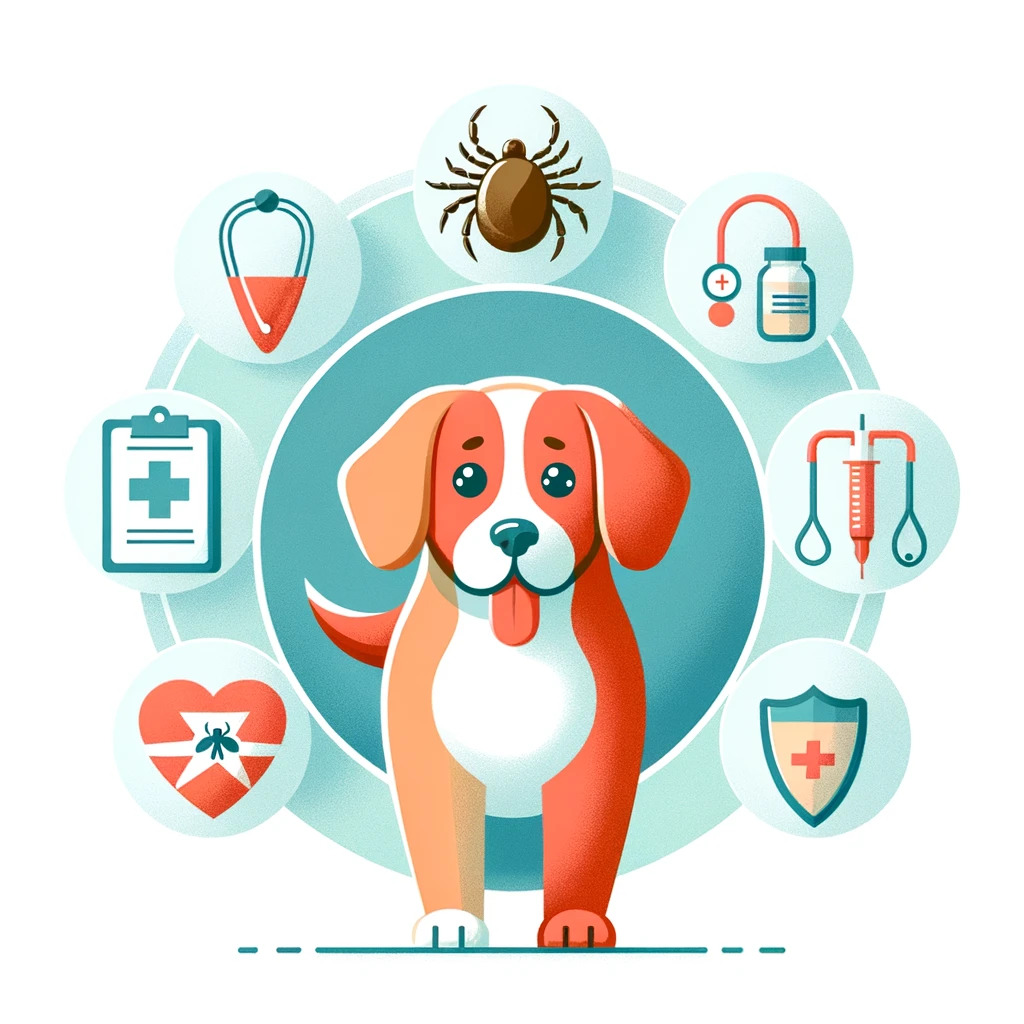Ehrlichiosis is a significant health concern for dogs, caused by the Ehrlichia bacteria transmitted through tick bites. This comprehensive guide aims to address the most common questions pet owners have about this disease, providing in-depth information to help keep your canine companion healthy and happy.
What is Ehrlichiosis in Dogs?
Ehrlichiosis is a bacterial illness primarily transmitted to dogs through the bite of infected ticks. This disease is caused by different species of the Ehrlichia bacteria, which target the white blood cells of dogs. The condition has various forms, depending on the specific Ehrlichia species involved. Understanding its nature, transmission, and effects on your pet’s health is crucial for effective prevention and treatment.
- Etiology: Ehrlichiosis is caused by Ehrlichia canis, Ehrlichia ewingii, and other species. These bacteria reside in white blood cells and can lead to systemic infection.
- Transmission: The primary vectors are ticks, particularly the brown dog tick (Rhipicephalus sanguineus) and others. Dogs get infected when bitten by a tick carrying Ehrlichia bacteria.
- Incubation Period: After a tick bite, it usually takes 1-3 weeks for symptoms to develop, though this period can vary.
- Symptoms: Early signs include fever, lethargy, loss of appetite, and swollen lymph nodes. As the disease progresses, more severe symptoms like bleeding disorders, neurological problems, and joint pain can occur.
- Stages of Infection: Ehrlichiosis typically progresses through three stages – acute, subclinical, and chronic. Each stage has distinct clinical features and implications for treatment.
- Diagnosis: Veterinarians diagnose ehrlichiosis based on symptoms, history of tick exposure, blood tests (like complete blood count and serology), and sometimes PCR testing to detect bacterial DNA.
- Treatment: The primary treatment is antibiotics, with doxycycline being the most commonly prescribed. Treatment duration can vary based on the disease stage and severity.
- Prevention: Effective prevention includes regular tick control measures, checking your dog for ticks, and keeping them away from tick-infested areas.
- Geographical Distribution: Ehrlichiosis is more prevalent in regions with high tick populations, but it can occur anywhere ticks are found.
- Impact on Health: If left untreated, ehrlichiosis can lead to severe health complications, including organ damage and death. Early detection and treatment are vital for a positive outcome.
How Do Dogs Get Ehrlichiosis?
Understanding the transmission of Ehrlichiosis is key to preventing this serious disease in dogs. Ticks are the primary culprits, and knowing the lifecycle and habits of these parasites can significantly reduce the risk of your pet contracting Ehrlichiosis.
- Tick Lifecycle: Ticks have four life stages – egg, larva, nymph, and adult. They require a blood meal at each stage after hatching to survive and develop.
- Infection Process: When an infected tick bites a dog, it transmits Ehrlichia organisms into the dog’s bloodstream.
- Types of Ticks Involved: The brown dog tick is the most common transmitter. However, other species like the Lone Star tick and the American dog tick can also spread the disease.
- Environmental Factors: Tick populations thrive in warm, humid environments, but they can be found in various climates.
- Seasonal Activity: Ticks are most active during spring and summer, although in warmer regions, they can pose a threat year-round.
- Dog’s Risk Factors: Dogs that spend a lot of time outdoors, especially in wooded or grassy areas, are at a higher risk of tick bites.
- Tick Control: Regular use of tick preventatives, such as topical treatments, collars, or oral medications, is crucial.
- Regular Checks: Regularly check your dog for ticks, especially after they’ve been outside in areas known for tick infestation.
- Prompt Removal of Ticks: If you find a tick on your dog, remove it immediately with tweezers, ensuring to get the entire tick out.
- Environmental Management: Keep your yard and outdoor spaces free of tall grasses and brush where ticks may reside.
What Are the Symptoms of Ehrlichiosis in Dogs?
Recognizing the symptoms of Ehrlichiosis can lead to a timely diagnosis and treatment, which is vital for your dog’s health. The symptoms can vary depending on the disease stage and the individual dog.
- Early Stage Symptoms: In the acute phase, symptoms include fever, lethargy, loss of appetite, and possibly swollen lymph nodes.
- Hematological Signs: There may be evidence of anemia, thrombocytopenia (low plate let count), or leukopenia (low white blood cell count), detectable through blood tests.
- Respiratory Issues: Some dogs may develop coughing or labored breathing.
- Eye Abnormalities: Conjunctivitis, hemorrhage within the eye, or other eye problems can occur.
- Bleeding Disorders: Nosebleeds, bruising, or blood in the stool may indicate clotting issues.
- Neurological Symptoms: In advanced cases, dogs might show signs of neurological impairment, such as unsteadiness or seizures.
- Joint Pain and Swelling: Lameness or reluctance to move due to joint pain is common.
- Weight Loss: Chronic infections can lead to significant weight loss and general debilitation.
- Behavioral Changes: Affected dogs may become depressed or show decreased interest in activities they usually enjoy.
- Chronic Phase Indicators: In the chronic phase, more severe symptoms like kidney failure, persistent lameness, or eye problems can develop, indicating a more advanced disease state.
How is Ehrlichiosis Diagnosed in Dogs?
Accurate diagnosis of Ehrlichiosis is crucial for effective treatment. A combination of clinical signs, history, and laboratory tests helps in confirming the disease.
- Veterinary Examination: A thorough physical examination by a veterinarian is the first step.
- Medical History: Information about tick exposure and symptoms is crucial.
- Blood Tests: Complete blood count (CBC) can reveal anemia, thrombocytopenia, or leukopenia.
- Serological Testing: Tests like ELISA or IFA can detect antibodies against Ehrlichia.
- Polymerase Chain Reaction (PCR) Testing: This test can identify Ehrlichia DNA in the dog’s blood.
- Biochemistry Profile: To assess the overall health and function of organs.
- Urinalysis: Helpful in evaluating kidney function, which can be affected in chronic cases.
- X-rays or Ultrasound: These imaging tests can assess organ involvement, especially in advanced stages.
- Bone Marrow Analysis: In some severe cases, a bone marrow sample might be necessary.
- Differential Diagnosis: It’s important to differentiate Ehrlichiosis from other diseases like Lyme disease, Rocky Mountain spotted fever, or immune-mediated diseases.
What is the Treatment for Ehrlichiosis in Dogs?
Effective treatment for Ehrlichiosis involves a combination of antibiotics and supportive care, tailored to the severity and stage of the disease.
- Antibiotic Therapy: Doxycycline is the primary antibiotic used for treating Ehrlichiosis in dogs.
- Treatment Duration: The duration typically ranges from 3 to 4 weeks, but may be longer in chronic cases.
- Monitoring Response to Treatment: Regular follow-up with the vet is necessary to monitor the dog’s response to treatment.
- Supportive Care: Depending on the symptoms, supportive care may include fluid therapy, pain relief, and other symptomatic treatments.
- Blood Transfusion: In severe cases with significant anemia or bleeding, a blood transfusion might be required.
- Nutritional Support: Proper nutrition is vital for recovery, especially in dogs with weight loss.
- Managing Complications: If the disease has caused organ damage or other complications, additional treatments may be needed.
- Preventing Reinfection: Continuing tick prevention measures during and after treatment is crucial.
- Long-term Monitoring: Some dogs may require ongoing monitoring for potential relapse or chronic health issues.
- Prognosis: With early and appropriate treatment, the prognosis for dogs with Ehrlichiosis is generally good, although chronic or severe cases can pose greater challenges.
How Can Ehrlichiosis in Dogs be Prevented?
Preventing Ehrlichiosis mainly involves effective tick control and awareness of the disease’s risks and transmission.
- Regular Use of Tick Preventatives: Use tick collars, topical treatments, or oral medications as recommended by your vet.
- Environmental Control: Keep your yard and surrounding areas free from tall grasses and brush where ticks thrive.
- Regular Tick Checks: After outdoor activities, especially in wooded or grassy areas, check your dog thoroughly for ticks.
- Prompt Tick Removal: Safely remove ticks as soon as they are found.
- Avoiding Tick-Infested Areas: Be cautious in areas known to have high tick populations.
- Year-Round Protection: In some areas, tick prevention might be necessary throughout the year.
- Educating Yourself: Understanding the signs, transmission, and risks of Ehrlichiosis can help in early detection and prevention.
- Vaccination: While there’s currently no vaccine for Ehrlichiosis, staying up-to-date with other vaccinations can help maintain overall health.
- *Regular Veterinary Check-ups: Regular check-ups with your veterinarian can help in early detection of tick-borne diseases and overall health monitoring.
- Community Awareness: Educating others in your community about tick prevention and the risks of Ehrlichiosis can help reduce the overall incidence of the disease.
What are the Long-Term Effects of Ehrlichiosis in Dogs?
Understanding the long-term effects of Ehrlichiosis is essential for managing your dog’s health post-recovery. Some dogs may experience lasting impacts, especially if the disease was severe or chronic.
- Chronic Joint Pain: Dogs that have suffered from Ehrlichiosis may experience ongoing joint pain or arthritis-like symptoms.
- Organ Damage: In severe cases, the disease can cause lasting damage to organs such as the kidneys or liver.
- Immune System Impairment: Ehrlichiosis can affect the dog’s immune system, potentially making them more susceptible to other infections.
- Ocular Problems: Chronic eye issues can be a residual effect of the infection.
- Recurring Symptoms: Some dogs might experience recurring symptoms or flare-ups, particularly in times of stress or illness.
- Behavioral Changes: Dogs who have been seriously ill might exhibit changes in behavior or temperament.
- Need for Ongoing Medication: In some cases, long-term medication might be necessary to manage symptoms or prevent relapse.
- Regular Veterinary Visits: Dogs that have had Ehrlichiosis should be monitored regularly by a veterinarian for any signs of recurrence or new health issues.
- Diet and Exercise: A balanced diet and appropriate exercise can help maintain the dog’s overall health and aid in recovery from long-term effects.
- Emotional Support: Providing emotional support and a comfortable living environment is crucial for dogs recovering from chronic or severe illnesses like Ehrlichiosis.
How is Ehrlichiosis Different from Other Tick-Borne Diseases in Dogs?
Comparing Ehrlichiosis with other tick-borne diseases helps in understanding its unique aspects and why specific diagnosis and treatment are important.
- Causative Agents: Ehrlichiosis is caused by Ehrlichia bacteria, while diseases like Lyme disease are caused by Borrelia bacteria.
- Symptom Variability: The symptoms of Ehrlichiosis can be more varied and sometimes more severe than other tick-borne diseases.
- Diagnosis Methods: Specific tests for Ehrlichiosis may differ from those used for diagnosing other tick-borne illnesses.
- Treatment Regimen: The antibiotic treatment for Ehrlichiosis, particularly the use of doxycycline, is specific and may differ from treatments for other diseases like Lyme disease.
- Geographical Prevalence: Ehrlichiosis and other tick-borne diseases may have different geographical prevalences, affecting different populations of dogs.
- Tick Vectors: The type of ticks that transmit Ehrlichiosis might differ from those spreading other diseases, influencing prevention strategies.
- Incubation Period: The time between infection and the onset of symptoms can vary between Ehrlichiosis and other diseases.
- Chronic Effects: The long-term effects of Ehrlichiosis, especially in untreated cases, can be distinct from other tick-borne diseases.
- Co-infections: Dogs with Ehrlichiosis can sometimes be co-infected with other tick-borne pathogens, complicating diagnosis and treatment.
- Preventive Measures: While tick prevention is key for all tick-borne diseases, specific strategies might vary based on the most common tick vectors in a particular area.
What Research is Being Conducted on Ehrlichiosis in Dogs?
Staying updated on the latest research is vital for understanding Ehrlichiosis and improving its management in dogs.
- Vaccine Development: Research is ongoing to develop effective vaccines against Ehrlichiosis.
- Diagnostic Techniques: Improvements in diagnostic methods are being researched for more rapid and accurate detection.
- Treatment Advances: Studies are focused on finding more effective treatments and understanding antibiotic resistance in Ehrlichiosis.
- Tick Control Innovations: New methods of tick control and prevention are under investigation to reduce the incidence of tick-borne diseases.
- Ehrlichia Pathogenesis: Understanding how Ehrlichia bacteria cause disease helps in developing targeted treatments.
- Epidemiological Studies: Research on the distribution and frequency of Ehrlichiosis aids in formulating public health strategies.
- Co-infection Dynamics: Studies on how Ehrlichiosis interacts with other tick-borne diseases are important for comprehensive treatment approaches.
- Genetic Studies: Investigating the genetic makeup of Ehrlichia bacteria can provide insights into disease mechanisms and potential treatment targets.
- Climate Change Impact: Research on how changing climates affect tick populations and, consequently, the spread of Ehrlichiosis.
- Community Education: Studies on the effectiveness of community education programs in preventing tick-borne diseases like Ehrlichiosis.
- Wildlife Reservoirs: Investigating the role of wildlife in maintaining and spreading Ehrlichia species to understand the full epidemiological cycle.
- Immune Response Studies: Research into the canine immune response to Ehrlichia infection can lead to improved treatments and understanding of disease progression.
- Long-Term Health Impact: Studies focusing on the long-term health impacts on dogs that have recovered from Ehrlichiosis provide insights into chronic care needs.
- Global Prevalence: Research into the global prevalence and spread of Ehrlichiosis helps in understanding and managing the disease on a worldwide scale.
- Alternative Therapies: Exploration of alternative or adjunct therapies, including nutritional support and holistic treatments, alongside traditional medicine.
This comprehensive guide offers detailed insights into Ehrlichiosis in dogs, aiming to enhance awareness, prevention, and treatment of this serious disease. Keeping informed and proactive in tick control measures are key steps in protecting your canine companion from Ehrlichiosis and other tick-borne diseases. Regular veterinary check-ups, prompt medical attention to symptoms, and staying abreast of the latest research and advancements are crucial for the health and wellbeing of our beloved pets.
How Does Ehrlichiosis Affect Different Breeds of Dogs?
Exploring the impact of Ehrlichiosis across various dog breeds is important for understanding any breed-specific vulnerabilities and tailoring prevention strategies.
- Breed Susceptibility: While all breeds can be affected by Ehrlichiosis, some studies suggest certain breeds may be more susceptible to severe forms of the disease.
- Genetic Factors: Research into genetic predispositions in certain breeds can help in understanding the variability in disease severity and response to treatment.
- Symptom Presentation: Identifying if certain breeds exhibit unique symptoms or disease progression patterns.
- Breed-Specific Treatment Responses: Evaluating if some breeds respond differently to standard treatments for Ehrlichiosis.
- Prevention Strategies: Tailoring tick prevention measures based on the lifestyle and habitat of different breeds.
- Veterinary Awareness: Ensuring veterinarians are aware of any breed-specific considerations when diagnosing and treating Ehrlichiosis.
- Owner Education: Educating owners of susceptible breeds about the increased risks and signs to watch for.
- Research Participation: Encouraging owners of specific breeds to participate in research studies to enhance breed-specific knowledge about Ehrlichiosis.
- Long-Term Health Monitoring: Understanding if certain breeds require more rigorous long-term health monitoring post-recovery.
- Community Breeding Practices: Evaluating breeding practices in the context of genetic predisposition to Ehrlichiosis, aiming to reduce vulnerability in future generations.
Conclusion
Ehrlichiosis in dogs is a complex and serious disease that requires a comprehensive understanding for effective management. From recognizing early symptoms to implementing effective prevention strategies, this guide serves as an essential resource for dog owners and veterinarians alike. The importance of regular veterinary check-ups, staying informed about the latest research, and being proactive in tick prevention cannot be overstated. As we continue to advance our knowledge and treatment approaches, the goal remains to ensure the health and wellbeing of dogs everywhere, safeguarding them against Ehrlichiosis and other tick-borne diseases. Remember, early detection and treatment are key to a favorable outcome for our canine friends.
Summary Table
| Aspect | Details |
| What is Ehrlichiosis? | A bacterial disease in dogs caused by Ehrlichia species, transmitted by ticks. |
| Transmission | Mainly through tick bites, particularly the brown dog tick and others. |
| Symptoms | Vary by stage; can include fever, lethargy, joint pain, bleeding disorders, neurological issues. |
| Diagnosis | Based on symptoms, history, blood tests (CBC, serology), and PCR testing. |
| Treatment | Mainly doxycycline for 3-4 weeks, supportive care, and in severe cases, blood transfusion. |
| Prevention | Tick preventatives, environmental management, regular tick checks, avoiding tick-infested areas. |
| Long-Term Effects | Can include chronic joint pain, organ damage, immune system impairment, behavioral changes. |
| Differences from Other Diseases | Unique symptoms, specific diagnostic tests, and different tick vectors compared to other tick-borne diseases. |
| Research | Vaccine development, improved diagnostics, treatment advancements, understanding disease mechanisms. |
| Effect on Different Breeds | Some breeds may be more susceptible; requires breed-specific awareness and management. |
Frequently Asked Questions
The first signs include fever, lethargy, loss of appetite, and possibly swollen lymph nodes. It’s important to note these symptoms can be subtle initially.
With proper treatment, dogs can recover fully from Ehrlichiosis. However, untreated or severe cases can lead to more serious health issues and potentially shorten a dog’s lifespan.
Yes, Ehrlichiosis can be cured with appropriate antibiotic treatment, usually doxycycline, given for 3-4 weeks or longer depending on the case.
Ehrlichiosis is not typically directly contagious between dogs or from dogs to humans. It is primarily transmitted through tick bites.
Untreated Ehrlichiosis can progress to severe health problems, including bleeding disorders, organ damage, and potentially death.
Some studies suggest certain breeds might be more susceptible to severe forms, but all breeds can contract Ehrlichiosis from tick bites.
Yes, dogs can get Ehrlichiosis more than once if they are bitten again by an infected tick. Ongoing tick prevention is crucial.



